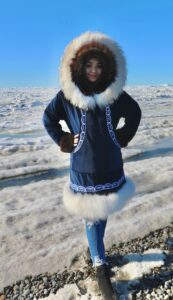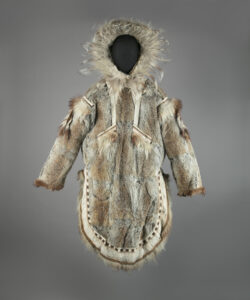LEGACY SOCIETY | APRIL 2023
Elizabeth and James Roghair Make a Tax Wise Decision and Support MOIFA
Did you know that if you are over 70 ½, you can transfer up to $100,000 from your IRA directly to the Museum of New Mexico Foundation and avoid paying tax on that income? Elizabeth and James Roghair, long-time Foundation members, have made a generous gift from their IRAs to support the upcoming Ghhúunayúkata / To Keep Them Warm: The Alaska Native Parka at the Museum of International Folk Art opening on May 21. Their gift not satisfies the required minimum distribution, but also gives them the satisfaction of knowing they are supporting a cause that is near and dear to them.
James and Elizabeth Roghair moved to Santa Fe in 2010 just in time for the 400th anniversary of the City. They rapidly became involved in the city’s museums and cultural institutions. Elizabeth had headed the planned giving programs at several Chicago area non-profits and James had retired from a long career as a pastor in places as far flung as Newark, New Jersey and Barrow (Utqiaġvik) Alaska.
As a gift planning professional, Elizabeth had learned to take maximum advantage of evolving opportunities to make tax-efficient gifts to non-profits through Individual Retirement Accounts. “During your working career you try to save as much as you can pre-tax – often getting your savings matched by your employer,” she explains. “These accounts grow tax-free until the day comes when you have to start withdrawing and paying income tax on what you have saved, according to an IRS formula. The way we look at it, our IRA’s are like mini-foundations. As soon as the law passed in 2006, that allowed us to avoid income tax on those withdrawals by having our IRA custodian send them as gifts to our favorite charities, we made it an annual practice to do a large part of our charitable giving directly from our IRA’s.” Each year, they include one or two special projects on their charitable gift list. These have ranged from medical research projects to sponsorship of concerts (Elizabeth sings in the Santa Fe Symphony Chorus), 50th college reunion scholarships, and sprucing up the campuses of their favorite cultural institutions. “We get the most joy from our contributions when they are tied to our own life experiences and passions,” says Elizabeth.

In 2022, Elizabeth and Jim learned about an upcoming exhibition of Alaska parkas at the Museum of International Folk Art. Parkas were very familiar to Jim’s family because they had lived on the North Slope of Alaska for over eight years where parkas with large fur-lined hoods were essential everyday clothing. Would the Roghairs be willing to become sponsors of the museum’s Parka exhibit? The answer was “Yes, we would be proud to share our Arctic Alaska connection with New Mexicans and other museum visitors.”
The tie to Alaska was a close one. In the summer of 1987 James Roghair, and his late wife Willa, packed up two hundred boxes of their personal and household goods and shipped them from a Post Office near Newark, New Jersey to Barrow, Alaska (now known by its Iñupiaq name Utqiaġvik). They had been called to serve as co-pastors of the Utqiaġvik Presbyterian Church. Their sons, 13-year old Nicholas and 11-year-old David, knew it was to be an adventure. The family had visited a large L. L. Bean store and purchased a supply of cold weather gear in preparation. But from their first week on the Arctic coast, they knew something else would be required. The cold, windy Fourth of July felt like snow as people celebrated on the Arctic Ocean beach. Everyone else was wearing an Alaskan parka!
As winter set in they realized the traditional native parka with its fur ruff kept the face warm in a way L. L. Bean couldn’t match. Jim obtained a handmade parka for daily use, with a wolf ruff, a velvet outer coat and a quilted lining. But with the need to travel to North Slope villages in a small airplane, he was glad to also become the owner of a “40-below-zero” parka with a Mouton (sheepskin) lining, and a corduroy shell. “It could make one sweat while shoveling snow at 40 or 50 below zero,” remembers Jim. Eight years later, Willa died, and the boys had gone off to college. Jim and Elizabeth (both widowed around the same time) were married and did not spend another winter in Utqiaġvik, rather making their home in Evanston, Illinois. Jim’s sons consider Utqiaġvik to be their home town and have returned there to live and work, David as the State Superior Court judge, and Nick as a Librarian in the Tuzzy Library of IlỊisaġvik College, a tribal college which is also part of North Slope Borough.
“Our Alaska connections remain strong, and it is delightful to be able to make sponsorship of this exhibition a focus of our latest IRA gifts” says Elizabeth with a smile.

Making a Gift from your IRA is Simple
To make a gift from your IRA, simply contact the financial institution that holds your IRA and provide them with information to make a direct transfer from the IRA to the Foundation. You may designate your gift to support one of the cultural institutions in the Museum of New Mexico system or the Foundation directly. The distribution counts toward your required minimum distribution (RMD) and you pay no tax on the distribution and the museum and/or the foundation benefits from your generosity. The new Legacy IRA Act also allows you to take up to $50,000 of your RMD and establish a charitable gift annuity or charitable remainder trust, saving on taxes and providing you guaranteed income for life.
Contact Laura Sullivan, Director of Leadership Giving/Legacy Society, at laura@museumfoundation.org or call 505.216.0829 for more information or to discuss ways to make a planned gift to the Foundation.
Photo captions (Top to bottom):
Bobby Lynn Brower (Iñupiaq), Atigi (parka) with isigvikpagaaq (sunshine ruff), 2020, Utqiagvik, Alaska, velveteen, wolf fur, wolverine fur, sea otter fur, ric rac, metal zipper. Museum of International Folk Art, IFAF Collection, museum purchase, FA.2022.16.1. Photo: Yves Brower, modeled by Hayleigh Nanook.
Fancy parka, Yup’ik maker, c. 1890, Arctic ground squirrel fur, wolverine fur, wolf fur, hide, wool. Museum of International Folk Art, IFAF Collection, gift of Louis Criss, FA.1974.42.1. Photo: Addison Doty.


Connect